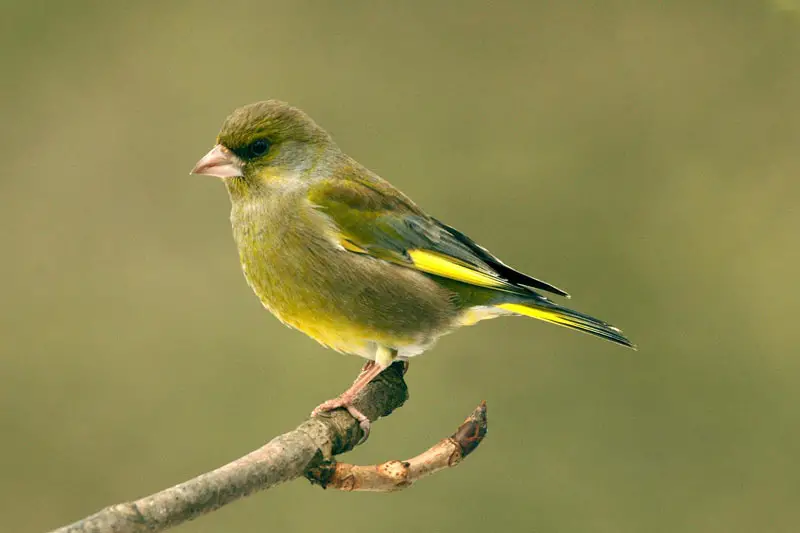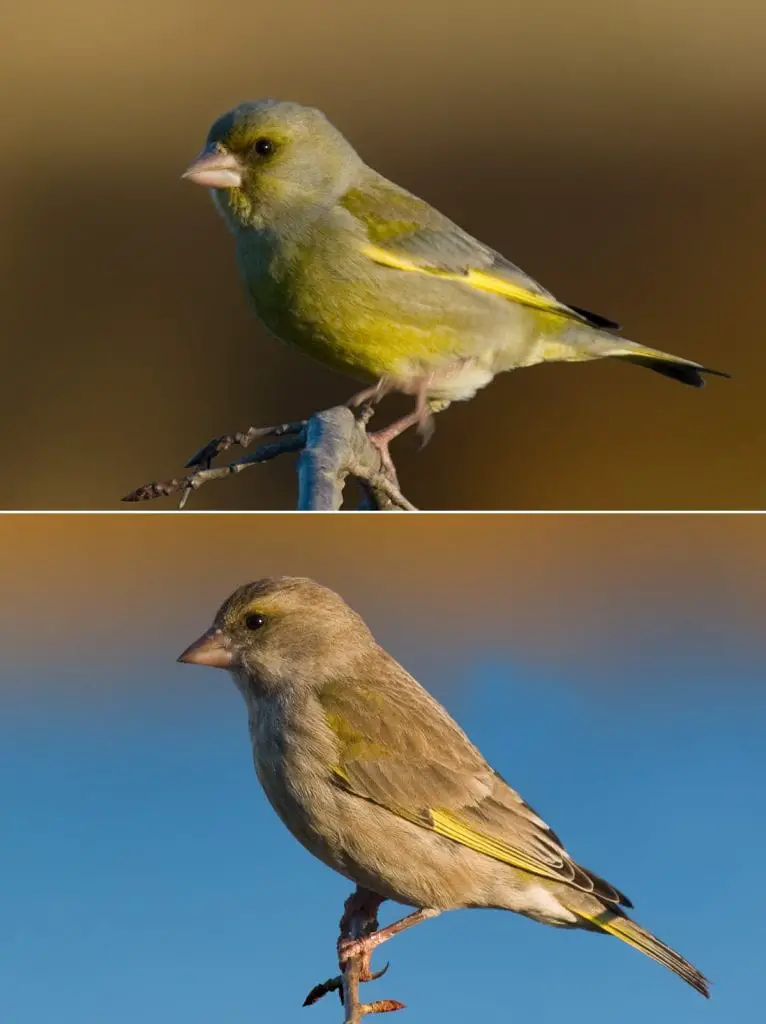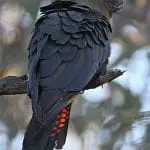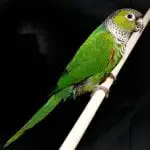Scientific Facts
| Common Name | European Greenfinch |
| Scientific Name | Chloris chloris |
| Lifespan | Over 7.5 Years |
| Size | 5.9 inches |
| Mass | 0.49 – 0.67 oz |
| Habitat | Terrestrial/artificial shrubland, forest |
| Range | Europe, west Asia, north Africa, Argentina, Uruguay, New Zealand, Australia |
Information & Physical Appearance

Scientifically referred to as Chloris chloris, the European greenfinch belongs to the order Passeriformes, the family Fringillidae, the subfamily Carduelinae. Another common name for the European greenfinch is simply greenfinch.
The family Fringillidae (the finch family) is divided into two subfamilies, namely the subfamily Fringillinae, and the subfamily Carduelinae.
The subfamily Carduelinae contains about 28 genera, which include 141 species.
The subfamily Fringillinae contains only a single genus, in particular, the genus Fringilla, which includes 3 species in total.
What is common for all the bird species that belong to the finch family Fringillidae is their stout, conical-shaped bills, as well as their seed-eating feeding habits.
Additionally, all finches possess similar skull morphologies, no crop (the crop is an expanded portion of the alimentary tract where food is stored prior to digestion), nine large flight feathers, and a total of twelve tail feathers.
In all species of finches, including but not limitedto the European greenfinch, it is the females to build the nests. Also, it is the females’ responsibility to incubate the eggs and brood the young chicks.
Contrary to cardueline finches that raise their young on regurgitated seeds, fringilline finches are known to raise their young almost completely on arthropods.
Up-to-date, there are ten recognized subspecies of European greenfinch.
The greenfinch subspecies inhabiting Ireland and Britain (except northern Scotland) is the C. c. harrisoni. The subspecies occupyingBulgaria, Greece, Montenegro to Moldova, and Serbia is the C. c. muehlei. The subspecies found in Norway to western Siberia, central and northern France, as well as northern Scotland, is the C. c. chloris.
The subspecies occupying Sardinia and Corsica are C. c. madaraszi, while the subspecies occupying southern Europe to western Greece, as well as southern Spain, is known as C. c. aurantiiventris.
C. c. turkestanica is the subspecies of greenfinch found in central Tajikistan and Kyrgyzstan to southern Kazakhstan. C. c. vanmarli is the subspecies found in northwestern Morocco, Portugal, and northwestern Spain, and the C.c. chlorotica is the subspecies found in northeastern Egypt to south-central Turkey.
C. c. bilkevitchi was described in 1911 and is known to occupy southwestern Turkmenistan, southern Ukraine, northern Iran, the Caucasus, and northeastern Turkey. C. c. voousi is the subspecies of European greenfinch occupying northern Algeria and central Morocco.
The European greenfinch is a relatively small bird, with adults typically reaching up to 5.9 inches in length. This bird’s wingspan varies from 9.6 to 10.8 inches.
Greenfinches are very similar in shape, as well as in size to the house sparrow (Passer domesticus). However, greenfinches’ coloration is visibly different from that of house sparrows, as greenfinches display mainly green colors, with the tail and wings being bright lemon-yellow in color.Female and young greenfinches, however, are duller in color as compared with adult males. Also, they have brown tones in the back zone. Their legs are pinkish.
“Equipped” with a conical, pinkish thick bill, the greenfinch’s song consists of interspersed wheezes, while the main part of the song consists of a series of trilling twitters. The song is wittily described as “not unpleasant.”
Lifespan

The maximum longevity of the European greenfinch is estimated at 13.6 years. However, this bird’s average lifespan is typically in the 7 years of the age range. Additionally, due to various factors in the wild, many greenfinches do only live for about 2-3 years.
The generation length is estimated at 4.2 years.
Ecosystem & Habitat

Chloris chloris is a widespread bird species that are found throughout southwest Asia, Europe, and North Africa. Nonetheless, the greenfinch has been successfully introduced into Argentina, Uruguay, New Zealand, and Australia. It was from Britain how the greenfinch was introduced into New Zealand back in 1862 – 1868 by the Acclimatisation Societies.
While the greenfinch is mainly resident throughout its range, some of the northernmost populations are known to migrate further south.
Food & Diet
Thanks to its heavy, specifically shaped as a conical bill, the greenfinch is capable of cracking larger seeds that other bird species fail to crack open.
It is mostly on seeds that greenfinches feed on. These birds will gladly feed on a wide variety of seeds from a number of crops. Because of this, they are commonly regarded as pests in some portions of their habitat.
Seeds are taken from an array of plants, shrubs, and trees, forming the bulk of the European greenfinch’s diet.
In particular, greenfinches are known to share a strong liking for the seeds of brassicas, such as wild radish and wild turnip, as well as cultivated rapeseed.
In general, greenfinches are reported to show some preference for seeds that occur within fleshy fruits, for instance, rosehips. It is often the case, though, that the birds will only eat the seed while totally ignoring the fruit itself. Seeds from hawthorn and yew are especially important during the autumn season, while bramble is especially important during the wintertime.
Pinus radiata seeds are also taken. Greenfinches may either take these seeds directly from the cones, or they can also take them from the ground.Nonetheless, thistle seeds are taken frequently. It is mostly from the ground how thistle seeds are taken by Chloris chloris. Additionally, these birds are known to extract the large-sized seeds of the variegated thistle plant’s heads as soon as they begin to open.
Other plant species included in the diet of the greenfinch include but are not limited to chickweed, dandelion, Amaranthus, wireweed, Poa annua, fat-hen. A wide range of berries seeds is eaten, too, e.g., African boxthorn and Cotoneaster.
It is not only seeds from wild plants but also seeds from cultivated species that the greenfinch is recorded to take. These include the seeds from sunflower, clover, maize, cereals, kiwifruit, tamarillo, clover, apple, and passionfruit.Although only making up for a minor part of their diet, invertebrates are also taken, as greenfinches have been observed to consume various flies, bugs, beetles, caterpillars, moths, and aphids.
Behavior
During the breeding season, greenfinches are monogamous. During the autumn and winter months, these birds are to form flocks, ranging in size from as few as 10 individuals to possibly reaching as many as 10 000 birds in number.
In the presence of good food sources, greenfinches will often form mixed flocks consisting of other finches, too. The flocks’ members are to forage annual weeds amongst crops.
It is a common belief that greenfinches are mostly sedentary. However, it is also a fact that greenfinches from the mainland have managed to reach many different outlying islands without human interference.
In summary, even though there is no evidence of regular migration executed by greenfinches, there is no doubt that local movements are to occur, and are mostly dictated by the availability of food.
Reproduction
With greenfinches, the breeding season occurs in spring. Breeding begins in mid-March and lasts up until June.
Chloris chloris species are fully capable of breeding when less than one year of age. Greenfinches do not produce only a single brood, but they produce two and sometimes up to three broods every year.
The young chicks are to fledge early in July.
The greenfinches’ nests have a fairly bulky structure. They are made out of fine twigs, grasses, and moss. Furthermore, the nests are lined with down, hair, and feathers.
In most cases, the nest is to be built either in a shrub or in a tree, positioned at the height of 2 – 3 meters on an average.
Normally, greenfinches are to lay 5 eggs.
The incubation of the eggs takes 13 and up to 14 days, and it is accomplished solely by the female. However, the male is to also assist the female engaged in eggs incubation by feeding her directly at the nest.
Upon hatching, the chicks are covered with long and thick down that is greyish-white in color. During the first days, both parents are to share the responsibility of feeding the young with insect larvae. Later on, the young chicks are frequently given a regurgitated paste of seeds, which is yellowish in color.
Even though the young are to leave the nest about 13 days after hatching, they are not able to fly yet, and instead, it takes them some extra days to fledge. It is in between 15 – 18 days after hatching that the young greenfinches are to fledge.
After successfully fledging, the young will keep being fed by their parents for some further 3 weeks or so.
When it comes to the greenfinches found in Australasia, their breeding season is to start from October, lasting up until March.Despite not being territorial, greenfinches are to defend a small area around their nest during their breeding season.
Health Risks, Survival Threats & Conservation
For quite some time, Trichomonas gallinae, a protozoal parasite, has been known to commonly infect raptors and pigeons, and it was mostly limited to this bird species being considered highly susceptible to the parasite.
However, starting in 2005 in the UK, carcasses of dead common chaffinches and European greenfinches have been discovered, with the dead birds reportedly having fallen victim to Trichomonas gallinae infection.
The deadly infection continued to spread among greenfinches. Thus, in 2008, Trichomonas gallinae-infected carcasses of dead Chloris chloris species were discovered in Finland, Sweden, and Norway. Just one year later, in 2009, carcasses of dead European greenfinches were also found in Germany.
It is strongly believed that the spread of this particular disease has been mediated by common chaffinches since a large number of chaffinches will breed in northern Europe. Also, large numbers of these birds are to winter in Britain.
In the United Kingdom, the number of infected carcasses was found to decline each year, following the peak that occurred in 2006. Ultimately, a reduction in the number of greenfinches was reported, as these birds’ population declined to about 2.8 million from about 4.3 million. However, no significant decline in the overall number of common chaffinches was observed.
Similarly, when the infection pattern occurred in Finland in 2008, a reduction in the number of greenfinches was reported, yet there was only a very small, insignificant reduction in the number of chaffinches.
Avian pox and Salmonella may also affect greenfinches.
The European greenfinch is listed as Least Concern on the IUCN Red List of Threatened Species. The number of mature individuals is estimated at 48 000 000 – 74 000 000, based on a 2018 assessment. The population trend is stable, and the species occurs in at least one protected area, while also being successfully monitored thanks to a systematic monitoring scheme.
Availability – Where to Get a European Greenfinch
It is possible to get a greenfinch to keep as a caged bird from a number of reputable vendors, both offline, as well as online. It is also possible to acquire a greenfinch directly from a trustworthy, experienced breeder.
Interesting Facts
1. It was in 2012 when the results of a molecular phylogenetic study proved that greenfinches are actually not closely related to other bird species in the genus Carduelis. Since greenfinches were part of the genus Carduelis at the time, (formerly known as Carduelis chloris), they were then placed into their current genus, the genus Chloris.
The genus Chloris was introduced by Georges Cuvier, a French naturalist, describing the European greenfinch as the type species in the genus.
2. Back in 1758, when Linnaeus became the first person to describe the European greenfinch, the bird species was known under the binomial name of “Loxia chloris.”
The specific word “chloris” is derived from the ancient Greek word “khloris,” which used to be the ancient name for the greenfinch, derived from “khloros,” which means “green.”
3. The display flight demonstrated by male greenfinches is described as a “butterfly” flight.
4. The European greenfinch has been domesticated in Malta after being continuously trapped for years. Nowadays, many people in Malta continue to breed it, as it is locally regarded as a very prestigious songbird. 5. There is a reported case of a European greenfinch individual having been observed to take bees directly from a beehive!How to Care for the European Greenfinch
One can choose to take good care of the wild greenfinches by providing these birds with some of their favorite foods at garden feeding stations. Greenfinches are strongly attracted to both sunflower hearts and black sunflower seeds, as well as to peanuts.
However, since trichomonosis can easily spread between greenfinches, as well as other birds at garden feeding stations, it is a must to clean the bird tables and feeders carefully on a regular basis. As a rule of thumb, the higher the concentration of birds at the feeding station, the higher the chance of getting possibly exposed to the infection.
Additionally, it is strongly recommended to take appropriate measures to help disperse the birds, thus, reducing possible contact between healthy and sick individuals in order to halt or slow down the outbreak.
If the bird care enthusiast is to notice a number of birds feeding at the feeding station showing trichomonosis symptoms, it is best to stop putting any food temporarily. Also, it is best to leave bird baths dry up until the point no further dead/sick birds are to be found on the ground.
Apart from gladly visiting bird tables, greenfinches are also known to be especially happy when it comes to perching on hanging feeders, where they can remain for as little as several minutes to more than ½ hours at times.
Other common health risks associated with greenfinches visiting garden feeding stations include avian poxvirus and Salmonella.
Avian pox virus is known to spread between birds by either direct contact, by biting insects, or by indirect contact through contaminated surfaces. Mind that this virus is resistant, and may persist on contaminated periods for especially long periods.
Then again, keeping the hygiene at bird feeding stations optimal is recommended to prevent avian virus outbreaks. In the case of an existing avian poxvirus outbreak leading to a large number of birds getting congregated, it is best to limit the amount of food provided at the feeding station to reduce close contact between healthy and sick individuals.When it comes to Salmonella infection, it is known to spread through droppings. Therefore, ensuring high hygiene is the best possible way to avoid the spreading of Salmonella. Do not forget that some types of Salmonella can cause food poisoning in humans, so it is a must to be especially careful when cleaning feeders and water containers, as well as when handling dead or sick birds.
Greenfinch Captive Care
1. Provide the greenfinch a good, balanced diet that includes canary grass seeds, green food, wild seeds, and a quality mixture of millets.
2. Some of the greenfinches’ favorite food sources include Thistle and Safflower.
3. Breeding greenfinches will require more green food.
4. Even though greenfinches are not as insectivorous as other bird species, they will enjoy live food offerings, such as small waxworms, mealworms, ant eggs, and fruit larva. Live foods should be provided only occasionally, mixed with soft food.
5. At all times, cage greenfinches must be supplied with fresh, clean water, grit, as well as a cuttlebone.
6. On a regular basis, captive greenfinches can be provided broccoli tops, chickweed, carrot tops, lettuce, spinach, egg food, and spray millet.
7. As a rule of thumb, sprouted seeds tend to be significantly easily accepted, as compared with vegetables and fresh fruits. Additionally, sprouted seeds possess an increased nutritional value and quality, as these seeds are high in vitamins, minerals, enzymes, chlorophyll, and vegetable proteins, while simultaneously being lower in fat than other seeds and grains.
8. Note that germinated niger and rape seeds, among other “oil” seeds, are especially rich in carbohydrates and protein, while germinated millets and canary seeds, among other “starch” seeds, are especially rich in healthy carbohydrates, yet rather low in protein.
9. Sprouted seeds are an invaluable food source for captive greenfinches at all times; however, these seeds are extremely important, vital to molting and breeding greenfinches. Also, germinated seeds serve as an excellent weaning food thanks to their softened shells that make it easy to crack the seed open, thus, helping the young chicks get better used to the seeds’ texture as they develop.
10. The European greenfinch has a long history of being kept as a caged bird. It is considered easy to take care of bird species, and it is also quite hardy.
11. Greenfinches love to bath. Thus, they require a fresh bath on a daily basis.
12. It is fine to keep European greenfinches with other birds of similar size in a mixed aviary. Also, individual pairs of greenfinches can be cohabitated.13. Similarly to canaries, one can choose to house greenfinches in individual breeding cages. However, greenfinches will live up to their fullest potential if provided a large planted aviary, as this will give them plenty of room to sing and fly.
14. European greenfinches can be very free breeders when it comes to established pairs. Their nest should be positioned high in the cage, for instance, in a sheltered spot located at the very corner of the cage. Since they need more privacy during breeding, adding artificial plant covering around the nest is highly recommended.15. Breeding pairs should be supplied with suitable nesting material, such as feathers, dried moss, or soft Canary nesting material.
FAQ Section
What Does a Greenfinch Look like?
Male greenfinches are colored in yellow-green overall, with the forked tail edges, as well as the wing bars, displaying vivid yellow coloration. Adult female greenfinches are grey-brown overall, their underparts are slightly streaky, and are further tinged with yellow hues, although on the tail and the wings, there is less yellow as compared with males.
Are Greenfinches Rare?
No, the greenfinches are not rare in all parts of their range; however, they have indeed become rarer in certain portions of their range, such as Britain. Because of the finch disease trichomonosis that occurs in 2005 in the UK, the local population of greenfinches has declined by about 35%, with these once ubiquitous garden birds becoming much rarer visitors at British garden feeders ever since.
How Many Eggs Does the Greenfinch Lay?
The female greenfinch is to lay between 4 and up to 6 eggs. The greenfinch will rear two and up to three broods per year.
How Big is a Greenfinch?
The greenfinch is small in size, reaching approximately 5.9 inches in length. The greenfinches’ wingspan is between 9.6 and up to 10.8 inches.
How Long Do Greenfinches Live?
According to some of the existing reports, greenfinches can live for up to 12 years of age; however, according to other reports, the maximum recorded longevity of the European greenfinch is over 13 years. Usually, greenfinches will only live for about 2 years in the wild but will live for longer in captivity, given the proper care.
What Does the European Greenfinch Eat?
The European greenfinch is known to eat buds, seeds, and berries from various shrubs, trees, and grasses. Greenfinches will also eat a certain amount of insects during the breeding season.
Are Greenfinches Endangered?
No, greenfinches are not considered endangered as of now. Greenfinches are listed as Least Concern on the IUCN Red List, with their populations being stable.



